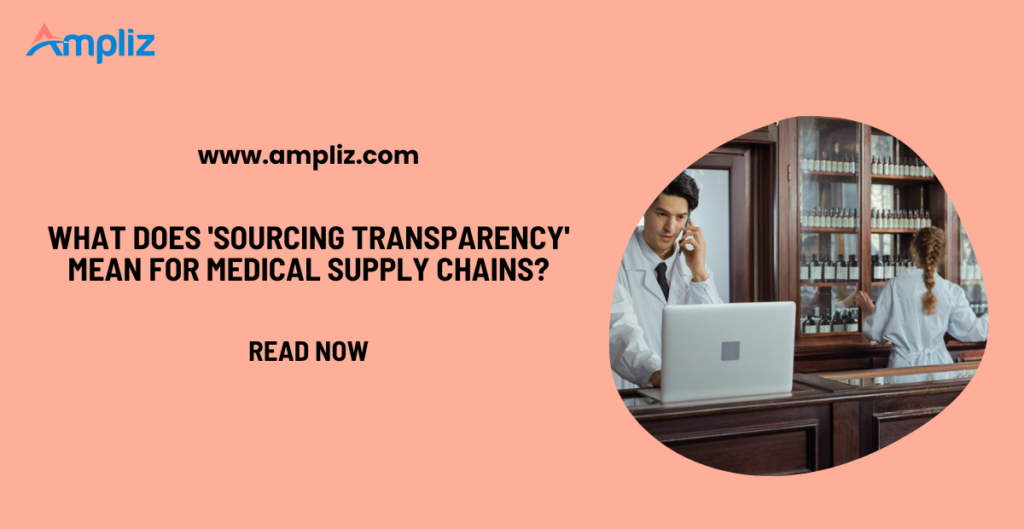Today, if you’re in the business of medical supply procurement, trust isn’t a given—it’s earned, batch by batch, and in each document you present. It’s a trust that’s increasingly measured by a single, high-stakes metric: sourcing transparency, especially when it comes to medical supplies.
To be quite blunt, supply chain opacity can cost people’s lives, from tainted infant formulas to counterfeit pharmaceuticals, the medical world has witnessed just how destructive unknown origins can be. Just one contaminated input or mislabelled component can trigger cross-border recalls, regulatory crackdowns, or even deaths.
Here’s the real kicker: transparency isn’t a nice-to-have—it’s a competitive moat you may need to harness. When you can prove every link in your chain—whether it’s baby formula from Demeter-certified farms in Germany or surgical gloves made with audited Malaysian rubber—you earn the trust that closes deals across borders.
So, what exactly is sourcing transparency? Does it matter much in APAC’s (Asia Pacific’s) booming healthcare ecosystems? Can you implement it in a way that wins business, builds trust, and outpaces your competitors? You may need these “specs” to break them down.
Why Sourcing Transparency Isn’t Just Jargon — It’s Your Lifeline
You’re in a world where medical supply chains stretch across continents—and one slipped segment can harm innocent lives. In these perilous times, “sourcing transparency” isn’t marketing fluff; it’s the exact process of knowing where every ingredient, material, and product component originated, how it was processed, and who oversaw its veracity.
This traceability can mean:
- Timestamps and GPS coordinates from farms and factories
- Certifications like GMP, ISO, Demeter, and that it’s organic
- Third-party verification via audits, blockchain, and RFID
In APAC—places like Manila, Singapore, and Ho Chi Minh (to name a few)—you’re expected to provide that documented provenance of each of your products. Also, more proactive regulatory bodies, hospital procurement teams, and end-users, especially in healthcare, now find transparency equally vital with safety and credibility.
The Surge: Transparency’s Moment in APAC
Here’s what’s driving the shift these days:
- Global SCM tech market for healthcare hit $3.6 B in 2025, growing at ~11% CAGR through 2034
- Asia‑Pacific growth: Healthcare SCM was $729 M in 2023, projected to reach $2.28 B by 2032 (CAGR 13.5%)
- Clinical logistics digitization in APAC: $5.67 B in 2024, expected to rise to $15.23 B by 2033 (CAGR 12.2%)
- Blockchain in pharma: a $2 B market in 2025, expected to ramp up 25% annually with supply-chain traceability tech surging
Now, if you’re supplying beyond your backyard, it’s no longer optional—it’s essential even for your first steps.
Premium Ingredients: A Niche You Can Own
When you highlight premium organic ingredients, especially in your milk, cereal, and other products, you’re talking about more than “just natural”—you’re promising a fully verified origin story, like:
- Dairy in infant formula sourced from Demeter-certified biodynamic farms
- Batch-level QR codes linking to org-chart style traceability
- Public dashboards showing soil health, animal welfare, and seasonal data
That’s not just to pacify suspicion—it’s trust built on hard proof over every representation you make. Today’s buyers, especially those in the APAC regions, expect and reward that—and they pay premiums for it because it gives them confidence and peace of mind. When they can see where something comes from and know it meets very stringent standards, it’s one less thing they have to worry about.
The Real Gains of Full Transparency
Here’s what transparency can unravel for you.
Regulation & Rapid Recall
You can effectively trace a contaminated batch in minutes, not days, to minimize or at least cushion the impact. Faster action often means less liability, less waste, and safer outcomes—for patients, suppliers, and the general consumers.
Buyer Confidence & Brand Differentiation
Today, more hospitals in Bangkok, Kuala Lumpur, and Manila often demand origin paperwork. Also, parents these days aren’t just buying formula—they’re buying stories along with it.
ESG & Ethical Leadership
With global ESG (environmental social governance) policies binding public institutions, supply-chain maps with farming practices, waste data, and certifications can help authenticate your story.
Premium Pricing & Repeat Business
Transparent sourcing consistently yields 5–15% price premiums in most studies; it’s not fluff—it can become your strategic edge.
Building Your Transparency Framework: A 7-Step Blueprint
Here are some steps to give you a hand in directly building your transparency groundwork.
Step 1: Deep-Map Every Tier
You may need to identify Tier 1–3 suppliers: farms, processors, component makers. List locations, certifications, and their production volumes.
Step 2: Set Clear Transparency Standards
Decide what matters—GMP, ISO, organic, biodynamic, blockchain traceability, digital lab reports.
Step 3: Gather Verifiable Proof
Collect scans of audit reports, certification stamps, GPS logs, and lab results—store them in an immutable system.
Step 4: Digital Traceability Tools
Use cloud SCM platforms with blockchain modules. Tag batches with QR/NFC codes for easy scans and audits.
Step 5: Audit & Independently Verify
Schedule third-party audits annually. Publish results—positive or negative—to reinforce trust.
Step 6: Publish & Promote
Show audit summaries, batch trace dashboards, and QR scans on packaging. Provide hospital portals and consumer QR links.
Step 7: Review, Refine, Repeat
Quarterly reviews: onboard deeper-tier suppliers, upgrade tech, respond to stakeholder input, optimize trace loops.
Proven Wins That Cement the Case
When a European brand offered Demeter-certified infant formula with full transparency into its dairy sourcing—from farm practices to seasonal production—it didn’t just check boxes–it won major hospital contracts across the APAC regions. In another case, a Malaysian glove supplier backed its product with GPS-tagged sourcing, ISO 14001 environmental standards, and labor welfare checks. The result? A huge drop in tender rejections or contract denials.
In this industry, you’re not just shipping supplies—you’re offering verified, high-trust sourcing of your products. And that’s exactly what procurement teams and health-conscious buyers are looking for these days.
What You Avoid with Transparency
- Dark-tier risks: unknown sub-suppliers hiding unethical practices
- Greenwashing disasters: you won’t be caught empty-handed by regulators or media
- Operational risks: increased costs (3–5%) are outweighed by savings from faster recalls, contract wins, and brand trust
Targeted Optimization: Reach Your Audience
You may want to nail these high-impact keyword phrases in all your campaigns, like:
- medical supply chain transparency
- ethical certified sourcing
- hospital procurement traceable components
- premium organic ingredients infant formula sourcing
You’ll also want to zero in on the decision-makers themselves, wherever your consumers are. In APAC, that means understanding not just what they want—but how they buy products like yours. It’d be great to harness some data-driven strategies so you can identify and engage your targets in these markets; trust, verified product origins, and direct, localized engagement are mostly what moves the needle in your favor.
Tech Trends Powering Transparency
Along with producers’ and suppliers’ efforts at transparency, tech can be the surging power that got its back, like:
- Blockchain-integrated smart packaging: 33% by traceability function in 2024, expected to spread quickly in pharma and medical supplies
- RFID + blockchain networks: accelerating in APAC to secure product traceability and authentication
- Cloud platforms & IoT: powerful tools managing digital twins, cold chain control, and real-time monitoring
- Supplier risk analytics: 68% of professionals expect risk escalation, driving adoption of proactive tools
Your Strategic Moves to Rein in Even Your APAC Market
You may now see the future of all your endorsements, and it’s high time to:
- Audit your current documentation and traceability capabilities
- Define transparency standards relevant to your market
- Upgrade your systems—ERP/cloud/blockchain— for full traceability
- Train your teams to communicate sourcing stories clearly
- Market your transparency—packaging, website, SEO, buyer decks
Because in all these, you’re not just marketing—you’re building resilience, trust, and competitive advantage in a worldwide arena.
Final Word: Why You Can’t Afford to Delay
Transparent sourcing isn’t optional—it’s strategic, so it can shield you from regulatory and operational risks, help you attract premium-paying, ESG-conscious buyers, and let you tap into regional demand across APAC’s $2.3 billion-plus healthcare supply chain management niche and market.
So, whether you’re sending infant formula or PPE to India or Jakarta, this is your blueprint for a trust-first medical supply chain and production.



